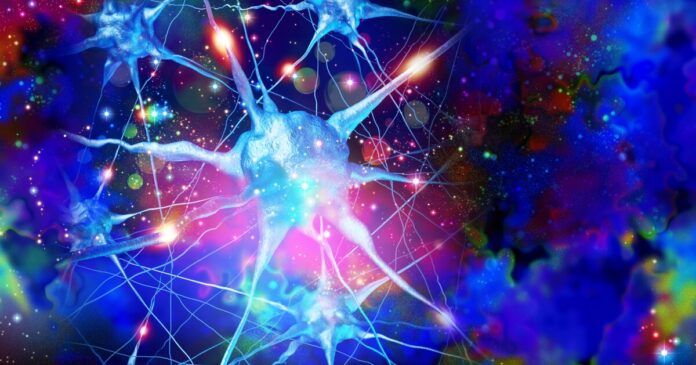A natural psychedelic may do more than alter perception. A new study found that at sub-hallucinogenic doses, DMT shielded the brain from stroke damage in animal models, reducing inflammation, preserving the blood-brain barrier, and speeding recovery.
The effects of an ischemic stroke, where blood supply to the brain is blocked, can vary depending on the area that’s affected, but commonly include physical impairments like one-sided weakness and balance issues, and cognitive challenges such as problems with speech and memory.
A new study by researchers in Hungary has investigated whether DMT, a naturally occurring psychedelic compound, could protect brain cells from damage caused by stroke in animal models. The results hold great promise for the development of a human treatment.
Produced by various plants and animals, the hallucinogen dimethyltryptamine (DMT) is known for its rapid, intense, and relatively short-lived effects among those who take it for its psychedelic effects or use it in religious rituals. In the present study, the researchers used a mix of lab-grown cell models and animal models that mimic the effects of ischemic stroke.
Neurons and other brain cells, which modeled the blood-brain barrier (BBB), were subjected to oxygen and glucose deprivation to simulate the conditions of a stroke. DMT was added either before or after this deprivation to test both preventive and therapeutic effects. In animal studies, rodents had their middle cerebral artery occluded, a standard stroke model in animals.
After stroke onset, DMT was administered intraperitoneally (into the abdominal cavity), followed by a continuous infusion for 24 hours, to see if it reduced brain damage and improved recovery. The researchers examined post-stroke cell survival and death rates, the size of areas of dead brain tissue (infarct), behavioral outcomes such as motor coordination and cognitive function, and inflammatory and neuroprotective signaling pathways activated by DMT.
What they found across cell and animal models was encouraging. DMT-treated cells exposed to stroke-like conditions showed significantly less cell death compared to untreated controls. In animals, brain damage was reduced – infarct volumes were notably smaller when DMT was administered after a stroke. Treated animals recovered motor function and cognitive performance more quickly and more fully than untreated, control animals. DMT appeared to suppress harmful inflammatory responses while promoting protective cellular pathways that helped cells resist stress and programmed cell death (apoptosis). The researchers found that DMT stabilized the BBB, reduced leakage of damaging molecules into brain tissue, and moderated the activity of microglia, the brain’s immune cells, all of which contributed to reduced inflammation and secondary damage.
There was also evidence that DMT promoted neuronal growth and repair processes, potentially aiding long-term recovery. Importantly, the beneficial effects were observed even when DMT was given after the stroke occurred, suggesting potential therapeutic use in emergency settings rather than just a preventive effect.
Of course, these experiments were conducted in labs, so a major limitation of the study is that we don’t yet know if these results will translate to humans. Further, the optimal dose, timing, and delivery method for DMT therapy have not yet been established, and effects may vary significantly. DMT’s hallucinogenic properties could complicate its clinical use. However, because beneficial effects were observed at sub-psychedelic doses, this may be manageable.
If the results translate to humans, DMT could become a groundbreaking new treatment for stroke, particularly ischemic stroke, where rapid intervention is critical. Potential clinical uses included emergency stroke therapy, as an adjunct to rehabilitation, and as a neuroprotective agent, which may expand the treatment’s relevance to traumatic brain injury and cardiac arrest.
Phase 2 human clinical trials are planned for later in 2025 to investigate the use of DMT as a treatment for stroke.
The study was published in the journal Science Advances.


